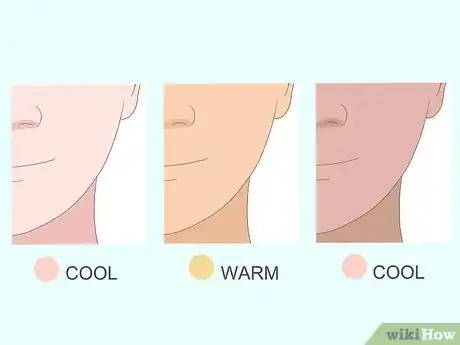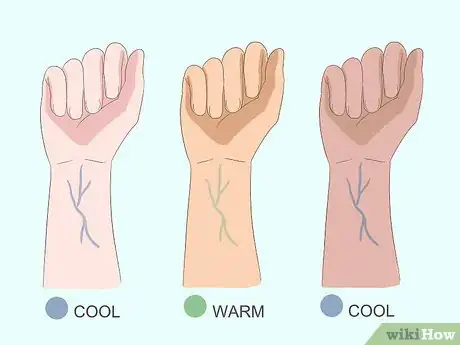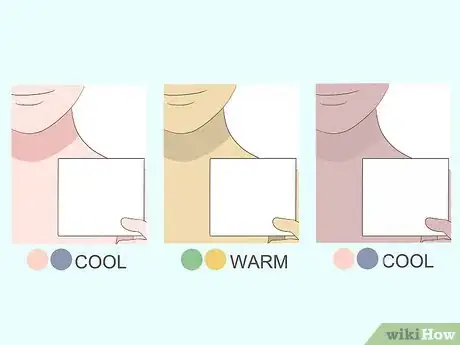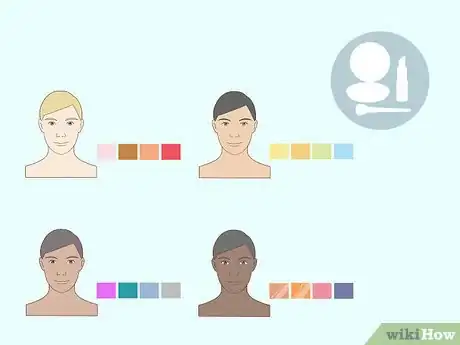This article was co-authored by Yuka Arora. Yuka Arora is a self-taught makeup artist who specializes in abstract eye art. She has been experimenting with makeup art for over 5 years, and has amassed over 5.6K Instagram followers in just 5 months. Her colorful and abstract looks have been noticed by Jeffree Star Cosmetics, Kat Von D Beauty, Sephora Collection, among others.
wikiHow marks an article as reader-approved once it receives enough positive feedback. This article has 13 testimonials from our readers, earning it our reader-approved status.
This article has been viewed 1,169,375 times.
Before you buy a new wardrobe, wedding clothes or other special occasion attire, it's best to know how to choose colors that flatter your skin tone. Choosing the wrong color can make your skin and hair appear dull, while the right colors for your skin tone can make you look vibrant. This article will help you determine your skin tone, then how to choose clothes, jewelry, makeup, and hair color that will make your complexion look bright and vibrant.
Steps
Determining Your Skin Tone
-
1Understand what skin tone is. Although individuals’ coloration span a very wide range of tones, there are only two basic types of skin tone: warm and cool.[1] Warm complexions have yellow undertones, whereas cool complexions have pink undertones. Though your skin may grow lighter or darker depending on how tan you are (whether from purposeful tanning or just from seasonal sun exposure), your skin tone will remain constant.
-
2Examine your veins. The skin on your wrist, elbows, and temples is very thin and has blood vessels close to the surface. If your skin color is light enough, you’ll be able to see the veins through the skin in these three locations.EXPERT TIPYuka Arora is a self-taught makeup artist who specializes in abstract eye art. She has been experimenting with makeup art for over 5 years, and has amassed over 5.6K Instagram followers in just 5 months. Her colorful and abstract looks have been noticed by Jeffree Star Cosmetics, Kat Von D Beauty, Sephora Collection, among others.Makeup Artist
 Yuka Arora
Yuka Arora
Makeup ArtistNot sure where to look? Makeup artist Yuka Arora says: "The easiest place to see your veins is on the back of your hand, or on the inside of your wrist, right under where your palm starts. If you have blue veins, your skin tone is cool, and if they're green, your skin has warmer tones. If you can't tell, it's probably neutral. But then, on top of that, you also might have a peach or olive undertone, so take that into consideration when you're shopping for foundation."
Advertisement -
3Give yourself the “white paper test.”[2] The skin on your face often has reddish tones that might lead you to believe you’re cool-toned, but the red might be coming from hormones, if you’re a woman, or sun exposure. Because of this, you want to use the skin on your throat and chest for this tape, not on your face.
- Hold a piece of clean white paper up to your throat and chest.
- Look at what colors jump out of your skin when juxtaposed against the white piece of paper.
- Blue and pink colors mean you have cool-toned skin.
- Green and gold colors mean you have warm-toned skin.
- The coloration for neutrals might fluctuate depending on the time of year and sun exposure.
-
4Give yourself the “jewelry test.” Again, you don’t want to compare colors against your face tones, so don’t use earrings for the jewelry test. Instead, you want to use necklaces or bracelets to analyze your coloration. You need gold and silver jewelry for this test. Under good natural lighting, look at how your skin appears against each color of jewelry.
- Which metal makes your skin look brighter and healthier?
- If you prefer gold against your skin, you are warm-toned.
- If you prefer silver against your skin, you are cool-toned.
-
5Consider how your skin responds to sun exposure. People with cool-toned skin tend to get sunburn more easily, whereas people with warm-toned skin tend to tan, rather than burn.
- Don’t overexpose yourself to the sun just to check whether your skin burns or tans!
- Instead, rely on past experience. If you have painful memories of sunburn, you’re probably cool-toned. If you can’t recall every getting sunburn, you’re probably warm-toned.
- If you find that you neither burn nor tan, or that your burns quickly heal into a tan, you are probably neutral-toned.
-
6Determine your season. Though in the previous section, you determined whether you were cool or warm-toned, there are two further subdivisions within these two categories. Summer and winter are both cool tones, whereas spring and fall are both warm tones.
- Summer: your skin has blue, red, or pink undertones during the white paper test; your hair and eye color contrasts gently against your skin color than winters.
- Winter: your skin has blue, red, or pink undertones during the white paper test; your skin contrast sharply against your hair and eye color (pale skin and black hair, for example)
- Spring: your skin has golden, cream, and peach undertones during the white paper test. Springs often have straw-colored or strawberry red hair, freckles, rosy cheeks, and blue or green eyes.
- Autumn: your skin has golden, warm or yellow undertones during the white paper test.
Choosing Colors That Works for Your Skin Tone
-
1Know which colors work for all skin tones. Some colors look good on everyone across the board, so people of all different skin tones should try to work bright red, pale pink, dark purple, and teal into their wardrobes.
-
2Wear clothes that match your skin tone.[3] Not all of your clothes have to match your skin tone perfectly because then you’d be wearing the same handful of colors over and over again. But you should make an attempt to maintain a steady rotation of colors that work well with your complexion, using other colors either as a pop or as a way to shake up your routine so your clothes don’t start looking monotonous.
- Summer: wear clothes in lilac and pale blue, and pastel and soft neutral shades with rose undertones. Softer colors will work better than vibrant ones.
- Winter: wear clothes with blue or pink undertones, or sharp colors like white, black, and navy blue.
- Spring: wear clothes with yellow and orange undertones like peach, ochre, and coral.
- Autumn: wear warm, deep colors like coffee, caramel, beige, tomato red, and green.
-
3Wear jewelry that matches your skin tone.[4] Remember the jewelry test you did to determine whether you were cool or warm-toned? Now that you know which metals make your skin look healthiest and brightest, incorporate more of those metals into your jewelry collection.
- Cool tones: summers should wear silver and white gold; winters should wear silver and platinum.
- Warm tones: Springs should wear gold; autumns can wear gold, bronze, or copper.
-
4Wear makeup that works well with your skin tone.[5] You should always wear foundation and concealer that matches your skin tone as perfectly as possible. For under-eye concealer, you want to buy a product one shade lighter than your actual skin tone, to brighten up the dark under-eye area. Remember that your skin tone may change from winter to summer, based on sun exposure, so adjust your makeup throughout the year as necessary.
- Very fair skin: if your skin can be described as “alabaster” or “porcelain,” you’ll look great in soft pink, tawny and beige tones, but want to avoid orangey reds. Nude and peach lipsticks look great for a daily shade, but a bright red will stand out for a dramatic look.[6] Avoid gray-based makeup like pale, frosty eye-shadows, as they tend to wash out your natural coloring.
- Medium-fair skin: wear makeup with yellow and pearlescent undertones, and gold flecks
- Medium-dark skin: your skin can work well with a wide range of colors, bright and punchy to pastel and understated. Experiment and see what fits your personal preference.
- Dark skin: wear rich, metallic hues like copper and bronze to highlight your natural tone. Bright berry tones on cheeks and lips can also pop really nicely. Avoid pale colors that look chalky, though.
-
5Adjust your hair color to bring out your complexion.[7] This is a drastic, longer-lasting change that just changing your clothes, jewelry, or makeup, so think long and hard about it before you dye your hair. That said, changing your hair color can go along way toward making your complexion look bright and fresh.
- Warm-toned skin with yellow/gold undertones: choose deep brown shades like chestnut and mahogany; coppery reds work well as highlights.
- Cool-toned skin with blue/red undertones: your skin will work well with contrast, so look for intense colors in brown, red, or blonde.
- Ruddy, reddish complexion: beige, honey, and golden hues will even out a ruddy complexion.
Community Q&A
-
QuestionI have brownish-black hair color, medium-fair skin tone and brown eyes. What should I wear?
 Community AnswerYou can pull off a range of colors. You'll look stunning in deep blues, purples, and reds, but also experiment with paler shades like light pink and ivory.
Community AnswerYou can pull off a range of colors. You'll look stunning in deep blues, purples, and reds, but also experiment with paler shades like light pink and ivory. -
QuestionI have blue eyes and veins, suggesting cool tones, but I also tan extremely easily and I've burned very few times. I have tan skin, blue eyes, and light brown hair, so what do I wear?
 Community AnswerI have extremely similar coloring, and I've always found that I look best in a pale blue. I imagine that would be true for you, too. With the conflicting blue veins vs. successful tanning, it might be possible that you have a neutral skin tone.
Community AnswerI have extremely similar coloring, and I've always found that I look best in a pale blue. I imagine that would be true for you, too. With the conflicting blue veins vs. successful tanning, it might be possible that you have a neutral skin tone. -
QuestionWhich colors will flatter my medium-fair, warm-toned skin, dark brown straight hair and brown eyes?
 Community AnswerDeep greens will look fabulous on you, as will grays. You should also try darker purples for a dressier look.
Community AnswerDeep greens will look fabulous on you, as will grays. You should also try darker purples for a dressier look.
References
- ↑ http://www.dailymakeover.com/beauty_tips/face/figuring_out_your_skin_tone/
- ↑ https://www.youtube.com/watch?v=zOYR1nJk32M
- ↑ http://attireclub.org/2013/04/18/choosing-the-colors-of-your-clothes-according-to-your-skin-tone/
- ↑ http://attireclub.org/2013/04/18/choosing-the-colors-of-your-clothes-according-to-your-skin-tone/
- ↑ http://www.bustle.com/articles/17962-how-to-choose-the-best-lipstick-for-your-skin-tone
- ↑ http://www.beautyriot.com/makeup-beauty/best-lipstick-skin-tone-g6681-page2
- ↑ http://www.cbsnews.com/news/the-right-hair-color-can-do-wonders/
About This Article
To choose colors that flatter your skin tone, determine whether you have cool or warm toned skin by looking at the veins on the inside of your wrist. Then, decide what season you are by holding a piece of white paper up to your skin and looking for its undertones. If your season is summer, meaning your skin has blue, red, or pink undertones and your hair and eyes softly contrast against your skin, wear pastel colors and soft neutral tones. If your skin is autumn, warm, deep colors like coffee and tomato red. For tips on matching your jewelry and makeup to your skin tone, read on!
